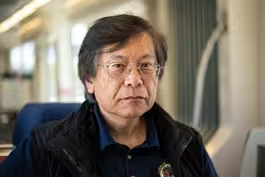
How intergenerational connections help older Americans
Clip: 5/11/2024 | 8m 6sVideo has Closed Captions
How intergenerational connections help older Americans stay happier and healthier
America’s population is older than it’s ever been, according to U.S. Census Bureau data. About 18 percent of Americans are at least 65 years old, a number that’s projected to hit 28 percent in 30 years. And as that demographic grows, some of them are reimagining retirement. Ali Rogin reports for our series, “Rethinking Aging.”
Problems playing video? | Closed Captioning Feedback
Problems playing video? | Closed Captioning Feedback
Major corporate funding for the PBS News Hour is provided by BDO, BNSF, Consumer Cellular, American Cruise Lines, and Raymond James. Funding for the PBS NewsHour Weekend is provided by...

How intergenerational connections help older Americans
Clip: 5/11/2024 | 8m 6sVideo has Closed Captions
America’s population is older than it’s ever been, according to U.S. Census Bureau data. About 18 percent of Americans are at least 65 years old, a number that’s projected to hit 28 percent in 30 years. And as that demographic grows, some of them are reimagining retirement. Ali Rogin reports for our series, “Rethinking Aging.”
Problems playing video? | Closed Captioning Feedback
How to Watch PBS News Hour
PBS News Hour is available to stream on pbs.org and the free PBS App, available on iPhone, Apple TV, Android TV, Android smartphones, Amazon Fire TV, Amazon Fire Tablet, Roku, Samsung Smart TV, and Vizio.
Providing Support for PBS.org
Learn Moreabout PBS online sponsorshipJOHN YANG: Census Bureau data says America's population is older than it's ever been.
About 18 percent of Americans are 65 years old or older.
In 30 years, it's projected they'll represent 28 percent of the population.
And as that demographic grows, some of them are reimagining retirement.
Ali Rogin's report is part of our series rethinking aging.
ALI ROGIN (voice-over): 76-year old Shelley Malinoff doesn't go to work anymore, but she doesn't feel retired.
SHELLEY MALINOFF, Mirabella Resident: There's the exercise class, and I leave it a little early to get to water aerobics at 9:00.
And then there's Tai Chi, and then I'm taking three classes on campus, so I do need to have time to do my homework.
The hardest thing is not to do too much.
ALI ROGIN: You have a busier schedule than most -- SHELLEY MALINOFF: Probably ALI ROGIN: -- millennials I know.
SHELLEY MALINOFF: Yeah.
Yeah.
Which is great.
ALI ROGIN (voice-over): Shelley lives at Mirabella, a luxury apartment complex for older adults right on Arizona State University's campus in Tempe.
She has access to ASU classes and facilities, and most important to her, access to the community.
CHARITY MORRISON, ASU Student: No Thursday is a busy day for you.
ALI ROGIN (voice-over): Charity Morrison is a graduate student here studying music, and she's part of Shelley's regular social group.
She's also one of Mirabella's artists in residence who perform for and with their older neighbors.
CHARITY MORRISON: One of the things that I really admire about Shelley is the moment we met.
She speaks so positively of the people around her and the experiences around her.
That's a characteristic that I really would love to emulate.
SHELLEY MALINOFF: You meet people that you had never, ever met before.
I mean, how -- Charity comes to dinner.
We're going to be cooking.
Where would I have met someone like Charity?
ALI ROGIN (voice-over): University based retirement communities are popping up at campuses countrywide, but Mirabella Lifelong Learning director Lindsey Beagley says fewer is integrated into everyday campus life ASU's model.
LINDSEY BEAGLEY, Senior Director of Lifelong University Engagement, Mirabella: These folks are really kind of pioneering the new retirement, which is a lifestyle that's centered on learning and deep, purposeful engagement.
ALI ROGIN: Studies show that intergenerational relationships are mutually beneficial.
Young people gain self-esteem and have better attitudes about older adults, and interacting with young people boosts the mental and physical health of their older counterparts.
WOMAN: Okay, my friends, these are the preschoolers coming in, so they've got a lot of energy.
ALI ROGIN (voice-over): One case study is the Benevilla Community Center for older adults in Arizona's West Valley, where many members are in the early stages of dementia.
One of its biggest draws is an on-site preschool.
Activities with Benevilla's grandmas and grandpas are built into the curriculum.
COLLEEN PETERSON, Member, Benevilla: When we get to see the little ones, it's very heartening.
It makes us all feel younger again.
ALI ROGIN: Benevilla member Colleen Peterson has family nearby but loves interacting with the younger generations here.
COLLEEN PETERSON: I had one little boy and he was just sobbing and sobbing, and I just kind of patted him, and then pretty soon he just slid right off my lap, went with the other kids and started playing.
ALI ROGIN (voice-over): Peterson has mild cognitive impairment, which led to depression and anxiety.
Her daughter Cathy says the children are a powerful antidote.
CATHY NASENBENY, Colleen Peterson's daughter: I think the best treatment is, you know, socializing and working with those kids is so cheerful, and I think that has really helped.
ALI ROGIN (voice-over): An added bonus, the kids benefit from these intergenerational interactions, too.
Aleena Smallman's three year old daughter Luna attends Benevilla's preschool.
ALEENA SMALLMAN, Staff, Benevilla: She's had so much fun in a couple of the different activities that they do that she'll just tell me about it for days or she'll ask me when she gets to go and see them again.
ALI ROGIN: Do you like being with the grandmas and grandpas?
Do you have favorite grandmas and grandpas?
ALI ROGIN (voice-over): Luna didn't want to hurt anyone's feelings, so she didn't names.
ALI ROGIN: Arizona is a popular retirement destination, but all across the country, there are plenty of programs for people who prefer to stay where they are.
Here in the nation's capital, a number of neighborhoods are bridging the generational divide for far less money.
ALI ROGIN (voice-over): 77-year old Fred O'Regan first moved to Washington, DC's Mount Pleasant neighborhood 40 years ago.
FRED O'REGAN: We had three children.
They grew up on this street.
They went to public schools here in DC.
Here, we'll walk to the school.
Come here.
Grab your bag.
We're going to walk to the school.
ALI ROGIN (voice-over): His kids moved out long ago, but O'Regan is still a fixture in the neighborhood.
He pays $50 a year to be part of his neighborhoods village movement.
It's a grassroots initiative that helps older adults stay connected to their communities.
There are 270 villages nationwide, with dozens more in development.
The first started in 2002 with a group of older neighbors in Boston.
BARBARA HUGHES SULLIVAN, Executive Director, Village to Village Network: They wanted to change the paradigm of aging, and they didn't want to move.
They loved their community and how to do that.
ALI ROGIN (voice-over): Barbara Hughes Sullivan is the executive director of the Village to Village Network, which connects individual communities.
BARBARA HUGHES SULLIVAN: They looked at the resources that were available to them.
What are the things as their aging they are going to need, such as possibility of transportation, most certainly social programs and more interaction, but also the capacity to volunteer.
FRED O'REGAN: Watch out for this guy here.
Hold on.
Get these kids out of the way.
ALI ROGIN (voice-over): Fred O'Regan volunteers with the Villages Safe Streets Initiative, a collaboration with the DC government.
Every school day, the street in front of the local elementary is closed during drop off and pickup.
FRED O'REGAN: Wait, wait.
ALI ROGIN: Fred's job twice a week is to guide students from the crosswalk to the school's entrance.
FRED O'REGAN: I didn't join the village because I was aging.
I joined the village because of its involvement in the overall community.
ALI ROGIN (voice-over): Principal Jessica Morales says the school needs the villagers.
JESSICA MORALES, Principal, Bancroft Elementary School: Without our volunteers, we would not be able to do this work.
It's been a very reciprocal kind of relationship where, like, they're keeping us safe and we're also building relationships with everyone.
ALI ROGIN (voice-over): Some villages charge up to $900 a year to support a small paid staff, but that's still far less than other programs for seniors.
The average annual cost of adult day programs is $20,000 and full time living arrangements can range between 50 and $100,000.
BARBARA HUGHES SULLIVAN: We have a very large population of middle class folks in this country, and they are not poor enough to receive state local governmental support services, but they're not wealthy enough to pay for those services either.
Villages appeal to all spectrums, all economic and socioeconomic communities, because it's there for everyone.
FRED O'REGAN: There are younger members of the village, which is great, and there are older members, and together that's the melding that really takes place, and that's the sort of dynamism.
And it's good for younger kids to interact with older people, to see that, well, these aren't just stuffy old people waiting for their wheelchair.
There's an integration process to this as well.
So it's meaningful to me.
ALI ROGIN (voice-over): Back in Arizona, Shelley Malanoff often winds down her day in the kitchen.
She was solo when we visited, but she often entertains.
SHELLEY MALANOFF: I don't want to be in a place with just older people because you're really limiting yourself.
So I feel it does make me feel better really being with younger people.
I never had kids, so for me it's, I can adopt them and I don't ever feel like they think of us as these old folks.
ALI ROGIN (voice-over): Malinoff doesn't think of herself that way either.
For PBS News Weekend, I'm Ali Rogin in Phoenix.
The historic legacy of Asian American photographer Corky Lee
Video has Closed Captions
Clip: 5/11/2024 | 4m 24s | The history-making legacy of Asian American photographer Corky Lee (4m 24s)
What to know about new COVID variants, bird flu and measles
Video has Closed Captions
Clip: 5/11/2024 | 6m 43s | What to know about new COVID variants and the spread of bird flu and measles (6m 43s)
Providing Support for PBS.org
Learn Moreabout PBS online sponsorship
- News and Public Affairs

FRONTLINE is investigative journalism that questions, explains and changes our world.

- News and Public Affairs

BREAKING the DEADLOCK sparks bold, civil debate on America’s toughest issues.












Support for PBS provided by:
Major corporate funding for the PBS News Hour is provided by BDO, BNSF, Consumer Cellular, American Cruise Lines, and Raymond James. Funding for the PBS NewsHour Weekend is provided by...

